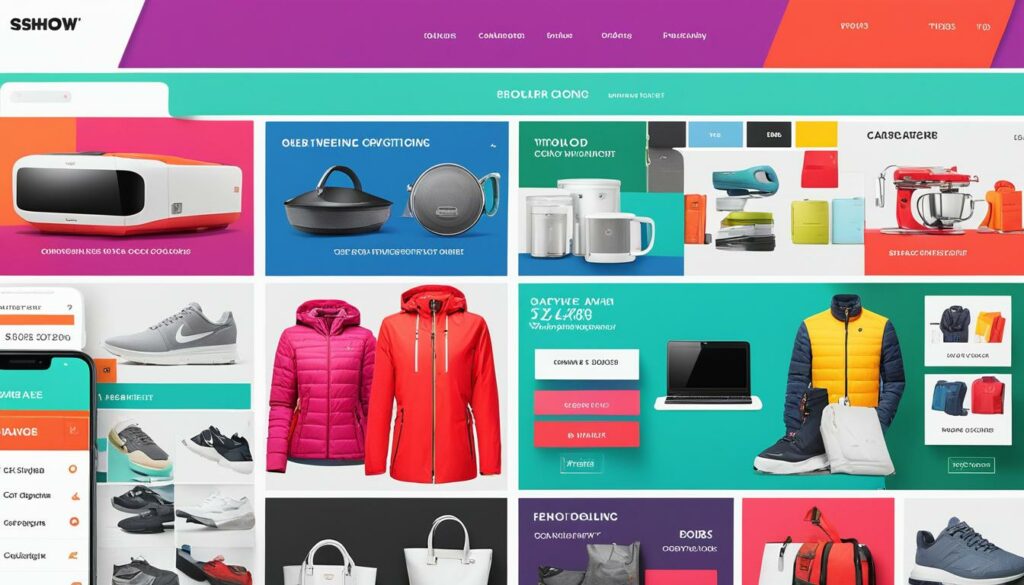A product catalog in ecommerce refers to the virtual showroom of an online store that showcases a wide array of products or services. It includes vital details such as product names, descriptions, prices, sizes, and captivating visuals. It serves as the digital shop window, inviting potential customers to browse and explore, mirroring the experience of strolling through aisles in a physical store. With intuitive search functions and convenient categorization, it enables shoppers to swiftly find their desired items. An ecommerce product catalog is crucial for providing a positive shopping experience, boosting sales, and shaping the overall online shopping experience.
Key Takeaways:
- A product catalog in ecommerce showcases a range of products or services in an online store.
- It includes essential details such as product names, descriptions, prices, sizes, and visuals.
- The catalog serves as a virtual shop window, mirroring the experience of browsing through physical aisles.
- Intuitive search functions and categorization help customers quickly find desired items.
- An effective ecommerce product catalog enhances the shopping experience and drives sales.
The Importance of Product Catalog in Ecommerce
A well-crafted product catalog plays a pivotal role in the success of an ecommerce business. It serves as the digital shop window, captivating potential customers and enticing them to explore and make purchases. The product catalog provides detailed information about products or services, empowering customers to make informed decisions. It amplifies the shop window effect by showcasing products in the best light and guiding customers to find exactly what they need quickly and easily.
But the importance of a product catalog in ecommerce goes beyond mere presentation. It streamlines the checkout process, ensuring a seamless and efficient transaction. With efficient wishlist functionality, customers can save and revisit their desired items at any time, making the shopping experience more convenient. Moreover, a well-managed product catalog enables real-time stock inventory management, avoiding the disappointment of out-of-stock items and enhancing customer satisfaction.
By investing time and effort into building a comprehensive and visually appealing product catalog, ecommerce businesses can create a compelling shopping experience that drives customer engagement and boosts sales.
Benefits of an Effective Product Catalog:
- Attracts and engages potential customers
- Provides detailed information for informed decision-making
- Enhances the shop window effect
- Facilitates quick and easy product discovery
- Streamlines the checkout process
- Enables efficient wishlist functionality
- Ensures real-time stock inventory management
- Enhances customer satisfaction
- Drives increased sales and revenue

| Key Elements of an Effective Product Catalog | Benefits |
|---|---|
| High-quality images | Brings products to life and sparks visual interest |
| Detailed descriptions | Provides comprehensive information for informed decision-making |
| Intuitive navigation | Enables users to easily find and explore products |
| Search functionality | Allows users to search for specific products quickly |
| Clear pricing information | Helps customers compare prices and make purchasing decisions |
Strategies to Improve Product Catalog in Ecommerce
Creating an effective product catalog is essential for optimizing your ecommerce website and attracting potential customers. By implementing the following strategies and best practices, you can enhance your catalog’s organization, appeal, and discoverability.
1. Visual Appeal and Descriptive Details
Start by emphasizing the visual appeal of your product catalog. Use high-quality images that showcase your products from different angles and provide a zoom feature for customers to examine product details. Alongside each image, include detailed descriptions that highlight key features, specifications, and benefits. This combination of visuals and information helps customers make informed decisions and boosts their confidence in purchasing.
“A visually enticing product catalog with detailed descriptions helps customers make informed decisions and boosts their confidence in purchasing.”
2. Intuitive Navigation and Logical Organization
Organize your catalog in a logical and user-friendly manner, making it easy for customers to navigate and explore. Categorize products based on relevant criteria such as product type, brand, or price range. Implement filters and sort options that allow customers to refine their search results based on their preferences. By providing intuitive navigation and logical organization, you streamline the browsing experience and help customers find products effortlessly.
3. Search Engine Optimization
Optimize your product catalog for search engines by incorporating relevant keywords and metadata. Conduct thorough keyword research to identify the terms your target audience is likely to use when searching for products. Incorporate these keywords organically into product titles, descriptions, and tags to improve your catalog’s visibility in search engine results. Additionally, optimize your catalog’s URL structure and meta tags to provide search engines with valuable information about your products.
4. Regular Updates and Maintenance
Regularly update and maintain your product catalog to ensure that it reflects the latest products and information. Remove outdated or discontinued products and add new arrivals promptly. Keep track of stock availability and update product availability information in real-time. By maintaining an up-to-date catalog, you avoid customer disappointment and inconveniences caused by inaccurate product information.
5. Interactive Elements, Personalization, and Analytics
Consider incorporating interactive elements into your product catalog to enhance customer engagement. Provide options for customers to leave reviews, ratings, or comments on products. Implement personalized recommendation features that suggest related or recommended products based on customer browsing and purchasing history. Additionally, leverage analytics to gather insights on customer behavior, popular products, and conversion rates. This data helps you refine your catalog strategy and make data-driven improvements to drive conversions.
Implementing these strategies and best practices will help you create an effective product catalog that engages customers, improves discoverability, and drives sales. Regularly assess and refine your catalog strategy based on customer feedback and market trends to stay ahead of the competition.
Customer Behavior and Product Catalog in Ecommerce
The product catalog in ecommerce plays a significant role in shaping customer behavior and driving sales. An effectively organized and visually appealing catalog has the power to attract and engage customers, encouraging them to spend more time browsing and making purchases. When customers visit an online store, they often rely on the catalog to explore different product options, compare prices, and read reviews.
The catalog serves as a virtual shopping guide, providing comprehensive product information and influencing customer decision-making. By showcasing products in an attractive manner and offering personalized recommendations, the catalog can effectively influence customer choices and increase customer satisfaction.
Effective product catalog management in ecommerce is therefore crucial for understanding customer behavior and optimizing the shopping experience. With proper categorization, intuitive navigation, and an appealing layout, businesses can ensure that customers easily find what they need. By including detailed product descriptions, high-quality images, and customer reviews, the catalog becomes a trustworthy resource for customers to make informed purchasing decisions.
An optimized catalog can also enhance the overall customer journey. Businesses can leverage data and analytics to gain insights into customer preferences and tailor the catalog to meet their needs. By providing a personalized and tailored experience, businesses can further engage customers, increase their time spent on the website, and drive conversion rates.

| Influence | Description |
|---|---|
| Product Discovery | The catalog serves as the primary platform for customers to explore and discover new products. |
| Comparison Shopping | Customers rely on the catalog to compare prices, features, and specifications of different products. |
| Information Source | The catalog provides detailed product information, including descriptions, specifications, and customer reviews. |
| Decision Influence | An appealing catalog can influence customer choices and guide their decision-making process. |
By understanding customer behavior, businesses can continuously improve their product catalog, enhancing the overall shopping experience and driving customer satisfaction and loyalty.
Challenges and Considerations in Product Catalog Management
Managing a product catalog in ecommerce presents unique challenges that require careful consideration. One of the primary challenges is ensuring data accuracy and consistency across the entire catalog. Providing customers with reliable product information is crucial for building trust and facilitating informed purchase decisions.
An additional challenge lies in managing and organizing a large number of products effectively. Proper categorization and easy searchability are essential features that enable customers to find what they are looking for quickly and effortlessly.
To stay competitive, it is important to stay updated with the latest industry trends and technological advancements in product catalog management. Implementing these advancements ensures a seamless user experience and keeps your catalog optimized for maximum conversion rates.
Balancing the use of text, images, and interactive elements is another consideration. Striking the right balance between providing relevant information and engaging visuals is crucial for capturing and retaining customer interest.
Regular monitoring and analysis of your catalog’s performance is necessary to identify areas for improvement. By analyzing metrics such as click-through rates, conversion rates, and customer feedback, you can make informed decisions to optimize your catalog and maximize its impact on your ecommerce business.
FAQ
What is a product catalog in ecommerce?
A product catalog in ecommerce refers to the virtual showroom of an online store that showcases a wide array of products or services. It includes vital details such as product names, descriptions, prices, sizes, and captivating visuals.
Why is a product catalog important in ecommerce?
A product catalog is crucial for providing a positive shopping experience, boosting sales, and shaping the overall online shopping experience. It acts as the digital shop window, attracting potential customers and encouraging them to explore and make purchases.
How can I improve my product catalog in ecommerce?
To improve the effectiveness of a product catalog in ecommerce, focus on creating an effective and visually appealing catalog with high-quality images, detailed descriptions, and intuitive navigation. Organize the catalog in a logical and user-friendly manner, optimize it for search engines, and regularly update and maintain the catalog to reflect the latest products and information.
How does a product catalog impact customer behavior in ecommerce?
An effectively organized and visually appealing catalog can attract and engage customers, encouraging them to spend more time browsing and making purchases. The catalog also plays a crucial role in influencing customer decision-making by providing comprehensive product information, showcasing products in an attractive manner, and offering personalized recommendations.
What are the challenges and considerations in product catalog management?
Managing a product catalog in ecommerce requires ensuring data accuracy and consistency, managing and organizing a large number of products, staying updated with industry trends and technological advancements, and balancing the use of text, images, and interactive elements. Regular monitoring and analysis of catalog performance are also crucial.
